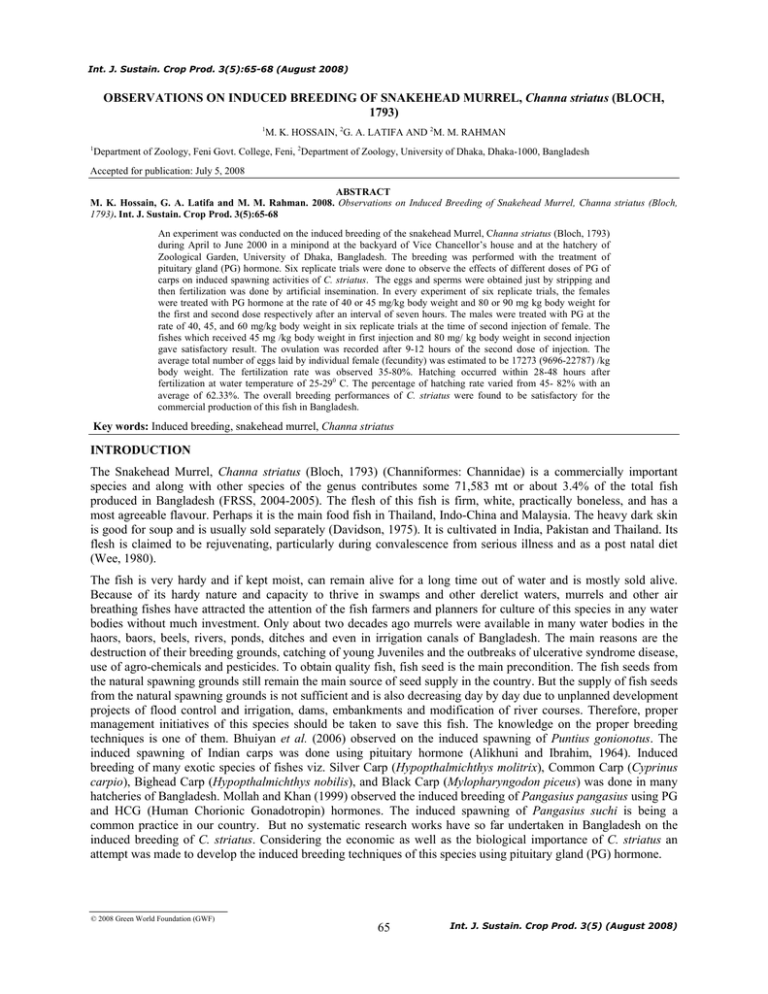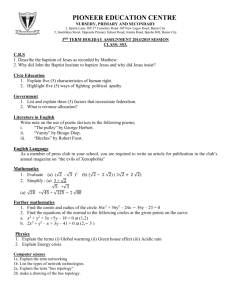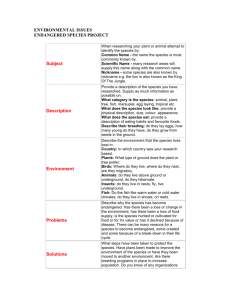Channa striatus 1793)
advertisement

Int. J. Sustain. Crop Prod. 3(5):65-68 (August 2008) OBSERVATIONS ON INDUCED BREEDING OF SNAKEHEAD MURREL, Channa striatus (BLOCH, 1793) 1 1 M. K. HOSSAIN, 2G. A. LATIFA AND 2M. M. RAHMAN Department of Zoology, Feni Govt. College, Feni, 2Department of Zoology, University of Dhaka, Dhaka-1000, Bangladesh Accepted for publication: July 5, 2008 ABSTRACT M. K. Hossain, G. A. Latifa and M. M. Rahman. 2008. Observations on Induced Breeding of Snakehead Murrel, Channa striatus (Bloch, 1793). Int. J. Sustain. Crop Prod. 3(5):65-68 An experiment was conducted on the induced breeding of the snakehead Murrel, Channa striatus (Bloch, 1793) during April to June 2000 in a minipond at the backyard of Vice Chancellor’s house and at the hatchery of Zoological Garden, University of Dhaka, Bangladesh. The breeding was performed with the treatment of pituitary gland (PG) hormone. Six replicate trials were done to observe the effects of different doses of PG of carps on induced spawning activities of C. striatus. The eggs and sperms were obtained just by stripping and then fertilization was done by artificial insemination. In every experiment of six replicate trials, the females were treated with PG hormone at the rate of 40 or 45 mg/kg body weight and 80 or 90 mg kg body weight for the first and second dose respectively after an interval of seven hours. The males were treated with PG at the rate of 40, 45, and 60 mg/kg body weight in six replicate trials at the time of second injection of female. The fishes which received 45 mg /kg body weight in first injection and 80 mg/ kg body weight in second injection gave satisfactory result. The ovulation was recorded after 9-12 hours of the second dose of injection. The average total number of eggs laid by individual female (fecundity) was estimated to be 17273 (9696-22787) /kg body weight. The fertilization rate was observed 35-80%. Hatching occurred within 28-48 hours after fertilization at water temperature of 25-290 C. The percentage of hatching rate varied from 45- 82% with an average of 62.33%. The overall breeding performances of C. striatus were found to be satisfactory for the commercial production of this fish in Bangladesh. Key words: Induced breeding, snakehead murrel, Channa striatus INTRODUCTION The Snakehead Murrel, Channa striatus (Bloch, 1793) (Channiformes: Channidae) is a commercially important species and along with other species of the genus contributes some 71,583 mt or about 3.4% of the total fish produced in Bangladesh (FRSS, 2004-2005). The flesh of this fish is firm, white, practically boneless, and has a most agreeable flavour. Perhaps it is the main food fish in Thailand, Indo-China and Malaysia. The heavy dark skin is good for soup and is usually sold separately (Davidson, 1975). It is cultivated in India, Pakistan and Thailand. Its flesh is claimed to be rejuvenating, particularly during convalescence from serious illness and as a post natal diet (Wee, 1980). The fish is very hardy and if kept moist, can remain alive for a long time out of water and is mostly sold alive. Because of its hardy nature and capacity to thrive in swamps and other derelict waters, murrels and other air breathing fishes have attracted the attention of the fish farmers and planners for culture of this species in any water bodies without much investment. Only about two decades ago murrels were available in many water bodies in the haors, baors, beels, rivers, ponds, ditches and even in irrigation canals of Bangladesh. The main reasons are the destruction of their breeding grounds, catching of young Juveniles and the outbreaks of ulcerative syndrome disease, use of agro-chemicals and pesticides. To obtain quality fish, fish seed is the main precondition. The fish seeds from the natural spawning grounds still remain the main source of seed supply in the country. But the supply of fish seeds from the natural spawning grounds is not sufficient and is also decreasing day by day due to unplanned development projects of flood control and irrigation, dams, embankments and modification of river courses. Therefore, proper management initiatives of this species should be taken to save this fish. The knowledge on the proper breeding techniques is one of them. Bhuiyan et al. (2006) observed on the induced spawning of Puntius gonionotus. The induced spawning of Indian carps was done using pituitary hormone (Alikhuni and Ibrahim, 1964). Induced breeding of many exotic species of fishes viz. Silver Carp (Hypopthalmichthys molitrix), Common Carp (Cyprinus carpio), Bighead Carp (Hypopthalmichthys nobilis), and Black Carp (Mylopharyngodon piceus) was done in many hatcheries of Bangladesh. Mollah and Khan (1999) observed the induced breeding of Pangasius pangasius using PG and HCG (Human Chorionic Gonadotropin) hormones. The induced spawning of Pangasius suchi is being a common practice in our country. But no systematic research works have so far undertaken in Bangladesh on the induced breeding of C. striatus. Considering the economic as well as the biological importance of C. striatus an attempt was made to develop the induced breeding techniques of this species using pituitary gland (PG) hormone. © 2008 Green World Foundation (GWF) 65 Int. J. Sustain. Crop Prod. 3(5) (August 2008) M. K. Hossain et al MATERIALS AND METHODS The experiments were conducted during the natural breeding season of C. striatus during April to June 2000 partly in a minipond at the backyard of the Vice Chancellor’s house, University of Dhaka and at the hatchery of the Zoological Garden, Curzon Hall, University of Dhaka. The matured male and female fishes were collected from brood rearing pond (minipond) and were transferred to the cemented tank (3m×2m×1m) for the conditioning of the fishes. The brood fishes were reared in the miniponds providing supplementary feeds, viz., small fishes, prawns, aquatic insects, tadpoles at the rate of 6% of their body weight per day and chicken-viscera was also fed at the rate of 2% of their body weight daily. Mature females were selected by their bulging soft abdomen, oval shaped reddish vent slit and smooth pectoral fins while mature males were selected by pale reddish vent slit and rough pectoral fins. Both sexes of the fish were of 1 -2 years old and the weights of male and female breeders were 0.480 – 0.750 kg and 0.525-0.660 kg respectively. The length of the male and female breeders varied from 25 to 32 and from 28 to 35 cm respectively. The experiment of induced spawning was designed with six replicate trials throughout the study period. The first dose for female consisted of 40, 45 and 60 mg of PG suspension (Prepared dose) per kg body weight of the fish in six different trials. The 2nd dose consisted of 80 and 90 mg/kg PG body weight of' the female. The 2nd dose was given after 7 hours of first injection. The males were given single dose at the time of 2"d injection of the female which was 45, 40, 60, 45, 40, 45 mg/kg PG body weight of the fishes in different trials respectively. Injections were made intra-peritoneally and in few instances, intramuscularly at the soft region at the base of the pectoral fin by means of a hypodermic syringe fitted with needle. After injection, spawners were returned to the cemented tank. Males and females were kept in the same tank of 1: 3 ratios. After 9-12 hours both males and females were taken out from the tank for stripping. Eggs and milt were collected by stripping method. Fertilization was done by mixing of eggs and milts (sperms) and gently stirred with a clean feather to hasten the fertilization of eggs. Sperms were allowed to remain with the eggs for 5-10 minutes, and then the excess sperms were removed by 3-4 consecutive washes with saline (0.36%) water. The transparent eggs were considered as fertilized ones whereas the opaque eggs were considered as dead eggs. The fertilization rate was calculated by the following formula: Number of fertilized eggs Fertilization rate = × 100 Number of total eggs The fertilized eggs were then transferred into a hatching jar and maintained an ambient water temperature (25- 29 0 C) and dissolved oxygen through continuous aeration. After 28-40 hours of fertilization, hatchling were started to come out from the egg shell and hatching was completed within another 8 hours. The rate of hatching was calculated by the following formula: Number of hatchling Hatching rate = ×100 Number of total eggs For estimation of fecundity 10 ripe female of Snakehead Murrel was randomly sampled. In the present study, fecundity of various sizes of C. striatus was estimated by gravimetric method. The fecundity of 10 specimens was computed by counts of ova in 10 samples of 1.0 g from each ovary following the method of Sevaraj et al. (1972). RESULTS AND DISCUISSION Induced spawning was performed with PG (prepared dose) for the first and second injected dose. The particulars of the induced spawning are presented in Table 1. The dose to the male breeders and the second doses to the females were applied after seven hours of the first dose given to females. Proper stripping time was found after 9- 12 hours of the second dose of injection. Parameswarn and Murugesan (1976) successfully induced the stripped murrel to spawn at Bhadra Reservoir Project (Karnataka) by hypophysation, using carp pituitary glands. An initial dose of gland varying from 2 to 20 mg/kg weight of fish was administered to the female and 0 to 20 mg/kg to the males. After 4 to 6 hours a higher dose ranging from 5 to 380 mg/kg was given to the females and 5 to 250 mg/kg to the males. Spawning took place in about 13 to 17 hours after the second injection. 66 Int. J. Sustain. Crop Prod. 3(5) (August 2008) Observations on Induced Breeding of Snakehead Murrel, Channa striatus (Bloch, 1793) Table 1. Particulars of induced spawning experiment of C. striatus using PG hormone No. of experiment 1 2 3 4 5 6 No. of injection Date Time (hr) First Second First Second First Second First Second First Second First Second 05.04..2000 05.04.2000 15.04.2000 15.04.2000 25.04..2000 25.04.2000 05.05.2000 05.05.2000 25.05.2000 25.05..2000 05.06..2000 05.06.2000 15.00 24.00 16.30 02.35 17.00 02.10 15.00 24.00 14.00 23.20 17.00 02.05 Weight of breeders (kg) Male Female Hormone 0.480 0.560 PG 0.500 0.650 PG 0.70 0.600 PG 0.750 0.660 PG 0.625 0.525 PG 0.560 0.660 PG Doses of injection (mg / kg) Male Female 45 45 90 40 40 80 60 60 90 45 45 90 40 40 80 45 45 80 Time of ovulation (hr) 12 10 9 12 11 10 The present study reveals that comparatively higher amount of hormones were used for the induced breeding of C. striatus. This may be due to the only use of PG hormones for first and second dose of injection. The proper stripping time of C. striatus was found to be after 9-12 hours after of second dose of injection. Konardt (1968) observed that the time required for ovulation of carp varies from 8 to 13 hours after the final injection depending upon temperature. In the present experiment the time required for stripping was near about same of that of Konardt (1968). The time of ovulation in Pangasius pangasius varied from 6-7 hours (Mollah and Khan, 1999). Rahman and Ahmed (2007) recorded this time as 7.5-8 hours in Red Piranha, Pygocentrus nattereri. The fecundity of C. striatus under different body sizes as well as per kg body weight has been shown in Table 2. The fecundity of 10 females of C. striatus was estimated. The minimum number of ova was 5430 from a fish of 31 cm of total length and of 0.560 kg body weight. The maximum number of ova was recorded as 15000 from a fish of 35 cm of total length and of 0.660 kg of body weight. The mean fecundity of C. striatus was estimated to be 17273 (range: 9696-22,787) per kg body weight, while the same for catla, rohu, mrigal and common carp is 150,000-240,000, 112,000-3,03,000, 50,000-250,000 and 90,000-140,000 respectively. Table 2. Showing fecundity of the 10 gravid female (C. striatus) under different sizes as well as per kg body weight Individual number 1 2 3 4 5 6 7 8 9 10 Body length (cm) 31 30 34 35 29 30 33 35 28 35 Body weight (kg) 0.560 0.550 0.650 0.650 0.600 0.600 0.650 0.660 0.525 0.660 Total Fecundity 5,430 8,020 12,435 12,000 9000 10,500 13,500 15000 6375 15000 Fecundity per kg body weight 9696 14581 19130 18461 15000 17500 20769 22727 12142 22727 Mean fecundity per kg body weight 17273 (9696-22787) Fertilization rate varied from 35- 80% with the average of 58.83% in six replicate trials (table 3). Hatching rate was not same in all trials, which varied from 45-82% with the average of 62.33%. Das et al. (2007) observed that the percentage of fertilization of eggs varied from 40 to 90 and the percentage of hatching from 25 to 75 in the induced breeding of Clarias batrachus.The rate of fertilization and hatching of P. nattereri were reported to range from 58-67% and 50-59 % respectively (Rahman and Ahmed, 2007). 67 Int. J. Sustain. Crop Prod. 3(5) (August 2008) M. K. Hossain et al Table 3. Showing fertilization and hatching rate of C. striatus in six replicate trials performed throughout the breeding season Number of trials 1 2 3 4 5 6 Fertilization rate (%) 35 55 60 80 60 63 Hatching rate (%) 45 60 65 82 60 62 Mean fertilization rate (%) Mean hatching rate (%) 58.83 (35- 80) 62.33 (45-82) It was observed from the present experiment, the fertilization and hatching rate were commercially viable for the production of fish in captive condition. Therefore, the present study reveals that induced spawning of C. striatus is possible through PG for large scale production of quality fish seeds. It is hoped that the induced spawning of this fish would reduce the dependency on the natural spawning for fry collection and may ensure the supply of fish seeds to the farmers in the right time of the year. REFERENCES Alikunhi K.H. and Ibrahim K.H. 1964. Preliminary observations on the spawning of Indian carps, Induced by injection of pituitary hormone, Indian J. Fish. 7(1): 1-19 Bhuiyan A.S., Islam K. and Zaman J. 2006. Induced spawning of Puntius gonionotus (Bleeker). J. Bio. Sci. 14: 121-125 Das M., Islam M.A. and Mughal G.U. 1992. Induced Breeding and Fry Rearing of Catfish, Clarius batrachus (Linn.). Bangladesh J. Zool. 20(1): 87-95 Davison A. 1975. Fish and Fish Dishes of Laos. Imprimerie Nationale Vientiane.202 pp FSSS (Fishery Resources Survey System). 2004-2005. Fishery Statistical Yearbook of Bangladesh. Department of Fisheries, Dhaka. 41pp Konardt A. G. 1968. Methods of breeding of the Grass Carp, Ctenopharyngodon idella (Val.) and Silver carp, Hypophthalmichthys molitrix (Val.). FAO Fish Report. 44 (4): 195-204 Mollah M.F.A and Khan M.H.K. 1999. Observations on induced breeding of Pangasius pangasius (Hamilton). Bangladesh J. Fish. 22 (1): 125-128 Parameswaran S. and Murugesan V.K. 1976. Breeding season and seed resources of murrels in swamps of Karnataka state. Journal of the Inland Fisheries Society of India. 8:60-67pp Rahman M.M. and Ahmed A.T.A. 2007. Studies on Breeding and Larval Development of Red Bellied Piranha, Pygocentrus nattereri Kner, 1858 in Bangladesh. Bangladesh J. Zool. 35 (2): 193-203 Sevaraj C., Radhakrishnan S. and Parameswaran S. 1972. Notes on the breeding season, fecundity and life history of a minor carp Labeo boggut (Sykes). Central Inland Fisheries Research Institute , Barrckpore, India. 4: 87-97 Wee K.L. 1980. Snakeheads: Their biology and culture. In: Advance in Aquaculture. Vol. III. (Ed., Roberts, T.J.) pp. 181-211 68 Int. J. Sustain. Crop Prod. 3(5) (August 2008)




